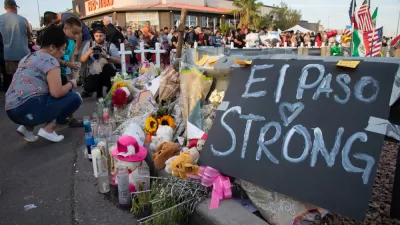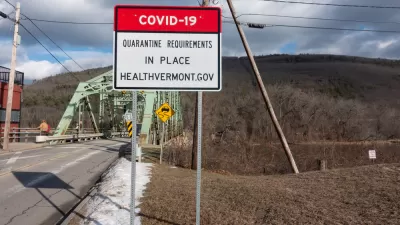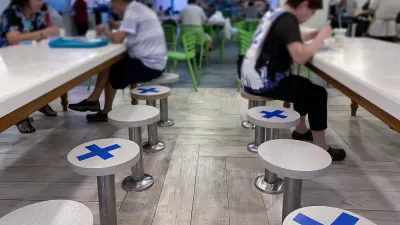The nation's smallest and second densest state has led the country in daily new cases per capita of coronavirus infections for the last week, supplanting the Midwest and Mountain States where the virus has reigned for months.

Rhode Island overtook Minnesota last Saturday to become the state with the most widespread coronavirus infections, according to a Providence Journal staff report dated December 6.
Rhode Island has reported an average of 1,169 new cases over the last seven days, or 110.3 new cases per 100,000 people per day.
By comparison, neighboring Massachusetts is 32nd in the country with 61.2 new cases per 100,000 people per day, and Connecticut is 33rd with 60.6 new cases per 100,000 people per day.
With the exception of Hawaii, Guam, Vermont, Puerto Rico, and Maine (though just barely), the entire nation is in the "red zone" as of December 10 due to COVID-19 case incidence exceeding 25 per 100,000 people, and stay-at-home orders are recommended, according to the Harvard Global Health Institute's "Key Metrics for COVID Suppression."
The United States, which has averaged 64 daily infections per 100k residents for the past week, has the sixth-highest case in the world after Georgia (119 per 100k), Serbia (104), Lithuania (92), Croatia (86) and Slovenia (72), according to The Washington Post global coronavirus tracker on December 10. In the United States, Rhode Island leads with 115 per 100k and Hawaii trails with 7 per 100k, according to the Post's national tracker.
Public health expert's perspective
"Dr. Megan Ranney, a Brown University emergency room physician, said there are a number of reasons why the densely populated, but small, state is experiencing such high infection rates, including lots of testing, having a high number of college students per capita seeding infections, and a family-oriented population contributing to super-spreader events," reports Dialynn Dwyer for Boston.com on December 9.
“We are the 2nd most densely populated state, with lots of multi-family and multi-generational homes,” Ranney wrote on Twitter. “This leads to fast spread, simply because people can’t distance from each other … We also have a lot of poverty, a lot of essential workers, & a lot of immigrants. And we know that economic & racial inequity are major drivers of transmission of the virus.”
Population density was one of three factors that Nick Landekic, a retired scientist who writes for Providence-based GoLocalProv, considered and dismissed in his opinion published December 5 (source article).
[T]he pandemic has been successfully contained in some of the most densely populated areas in the U.S. such as New York City... and the San Francisco Bay area... It has also been contained in many densely populated countries including Japan, South Korea, Taiwan, and China. Additionally, some of the highest infection rates are currently found in some of the lowest population density states in the country, including South Dakota, Wyoming, and North Dakota.
All of this makes it hard to point a finger at density as a major factor in Rhode Island’s pandemic catastrophe.
The other two possible explanations that Landekic considers are age of state residents and the nursing home population.
The lowest infection rates are currently in Vermont and Maine, both of which have older populations than Rhode Island (Maine has the oldest in the country).
COVID-19 cases in Rhode Island nursing homes represent about 4% of all cases, in line with the range of 2%-6% across other northeast states.
Landekic prefaces his analysis by writing that he has not done a "rigorous scientific study, and no statistical analyses were used. This is simply a very preliminary broad-brush look at the publicly available data, in hopes that more comprehensive work might be done by experts such as at the renowned Brown University School of Public Health."
What went wrong in Rhode Island?
The simple answer as to why things went so dreadfully wrong here is the mismanagement of the crisis by our political leaders. [See "Landekic: Raimondo Needs to Lead on Coronavirus."] Rhode Island has the second-highest infection rate in the country and one of the fastest-growing. There is no getting around the fact that management of the pandemic here has been a complete, cataclysmic failure. We are rapidly becoming a humanitarian disaster.
As noted above, much of Landekic's analysis is based on comparison to other New England states, particularly Vermont and Maine, which shut down earlier and opened later than Rhode Island.
Close downs work. They are the only thing that works in the pandemic, and especially when the situation has been allowed to get as totally out of control as it has in Rhode Island
The dramatically different experiences of Rhode Island vs. Vermont and Maine, as well as those of countries around the world where the pandemic has been successfully contained, prove the power of proper containment measures.
What lies ahead
As bad as things are in the Ocean State, it's going to get worse. Dwyer of Boston.com writes that "the worst of the surge — the impacts of the Thanksgiving surge — are also still a few weeks away, just in time for the Christmas holiday when experts fear more indoor gatherings will occur." Dr. Ranney gets the last word:
“At the end of the day, regardless of the reason, our hospitals are overwhelmed and everyone knows someone who’s sick,” the emergency room doctor said. “We are calling for retired [health care workers] to volunteer, while allowing people to eat in-person at Denny’s. We are, frankly, in a very bad spot. With no sign of slowing.”
Related in Planetizen:
-
Hospitals and Healthcare Workers Brace for Influx of COVID Patients, December 3, 2020
-
We are Entering the Steep Slope of the Epidemic Curve', November 1, 2020
- The Changing Geography of the Pandemic, August 27, 2020
FULL STORY: What Went Wrong in Rhode Island With the COVID-19 Pandemic?

Alabama: Trump Terminates Settlements for Black Communities Harmed By Raw Sewage
Trump deemed the landmark civil rights agreement “illegal DEI and environmental justice policy.”

Study: Maui’s Plan to Convert Vacation Rentals to Long-Term Housing Could Cause Nearly $1 Billion Economic Loss
The plan would reduce visitor accommodation by 25% resulting in 1,900 jobs lost.

Planetizen Federal Action Tracker
A weekly monitor of how Trump’s orders and actions are impacting planners and planning in America.

Restoring Northern India’s Himalayan ‘Water Temples’
Thousands of centuries-old buildings protect the region’s natural springs and serve as community wells and gathering places.

Milwaukee to Double Bike Share Stations
Bublr Bikes, one of the nation’s most successful, will add 500 new e-bikes to its system.

DC Extends Application Window for Outdoor Dining Permits
District restaurants will have until the end of November to apply, but businesses with permits in rush hour parking lanes must end operations on July 31.
Urban Design for Planners 1: Software Tools
This six-course series explores essential urban design concepts using open source software and equips planners with the tools they need to participate fully in the urban design process.
Planning for Universal Design
Learn the tools for implementing Universal Design in planning regulations.
Caltrans
Smith Gee Studio
Institute for Housing and Urban Development Studies (IHS)
City of Grandview
Harvard GSD Executive Education
Toledo-Lucas County Plan Commissions
Salt Lake City
NYU Wagner Graduate School of Public Service





























